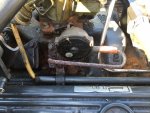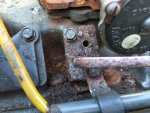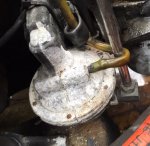I have a 1988 Four Winns Horizon 200 -- quite the project boat 
OMC 502APRGDP
Carburetor Info - Rochester R2-MRIN2 (#17059060)
Engine will turn over and stays running at a higher RPM but dies out at idle speed - 800 RPMs. If I throttle up to 1,000 or 1,200 RPMs, engine stays running. But, when i come back down to idle (800 RPMs) the engine will stall.
I think I found the problem. It is on the carburetor. Specifically, on the automatic choke (heat choke) -- choke heat tube coming off the manifold.The tube has rusted and has a hole in it. I am assuming the choke is closed longer than it should be without the hole in that tube.
I found a replacement heat tube. Also bought a new choke thermostat.
My question -- how do I remove the old heat tube? The "choke stove" on manifold has one good bolt and one seriously rusted bolt. Does the old tube come out of the "choke stove"? Or, do I need to drill out the rusted bolt and remove the "choke stove"?
Pictures attached.
OMC 502APRGDP
Carburetor Info - Rochester R2-MRIN2 (#17059060)
Engine will turn over and stays running at a higher RPM but dies out at idle speed - 800 RPMs. If I throttle up to 1,000 or 1,200 RPMs, engine stays running. But, when i come back down to idle (800 RPMs) the engine will stall.
I think I found the problem. It is on the carburetor. Specifically, on the automatic choke (heat choke) -- choke heat tube coming off the manifold.The tube has rusted and has a hole in it. I am assuming the choke is closed longer than it should be without the hole in that tube.
I found a replacement heat tube. Also bought a new choke thermostat.
My question -- how do I remove the old heat tube? The "choke stove" on manifold has one good bolt and one seriously rusted bolt. Does the old tube come out of the "choke stove"? Or, do I need to drill out the rusted bolt and remove the "choke stove"?
Pictures attached.
























